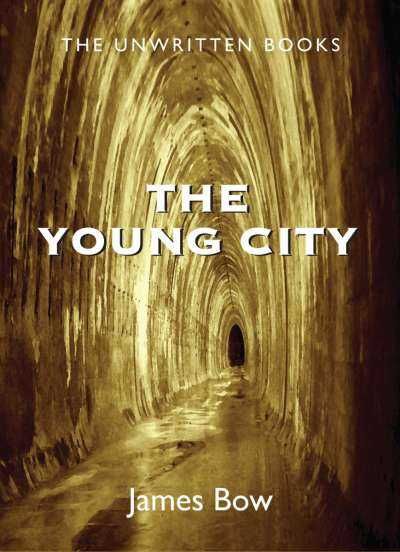That Time We Shared Together
The Young City (The Unwritten Books, volume 3)
By James Bow

1 Sep, 2017
0 comments
2008’s The Young City is the third and last volume in James Bow’s The Unwritten Books trilogy.
For Rosemary Watson, helping her brother Theo move into his Toronto apartment was meant to be a prelude to her own foray into adult life. She and her boyfriend Peter McAllister were soon to start uni in Waterloo and London, Ontario1 respectively.
Adult life intervenes unexpectedly. The floor of Theo’s basement apartment collapses and drops Rosemary and Peter into the long-buried Taddle Creek. Emerging from a storm drain, the couple find themselves in a very unfamiliar Toronto. The problem wasn’t the floor; it was the structure of space-time itself2.
The two find themselves thrown back into the year 1884. Toronto is much, much smaller than it will be in a future century. It is also considerably more socially conservative. While Peter’s clothes look odd, Rosemary’s are scandalous, particularly given that the couple appear on a Sunday. Calamity is only averted thanks to the intervention of Good Samaritan Faith Watson and her brother Edmund.
Although Faith has her doubts about Rosemary and Peter’s bona fides, the coincidence of a shared surname and the principle of Christian charity is enough for the Watsons to give Rosemary and Peter a chance. In short order, the modern pair, posing as a married couple, begin to build a new life in 1884.
Mere survival does not satisfy. What they really want is find their way home to the 20th century. They return to the spot where they emerged from the Taddle and try to find the underground passage that led them to old Toronto. No luck. A deadline is looming: 1884 is the year that the Taddle was completely buried. If they do not find their way home soon, Rosemary and Peter may be trapped in the past.
Their situation seems hopeless, until the day that Peter notices one of the watches in Edmund’s pawn shop has a very modern battery. Rosemary and Peter may not know how to find the gate, but someone in 1884 Toronto must. But will whoever it is be willing to share their secret with the couple? Or will this someone simply kill them to hide the gate?
~oOo~
Rosemary and Peter want to escape because the past is no fun. No antibiotics (that cut may kill you if it gets infected), smug bigots, Sunday laws (no fun for YOU on Sunday), widespread disapproval of education for women. I could add that life was about to get much worse for the First Nations people, but this was out of the scope of the book.
Our protagonists also feel that they must return to the 20th century so that they can tell their loved ones what happened. Silly! They should have known (the author should have known) that it is possible to send a message to the future. Store message in bank lock box, pay in advance to have box opened and message delivered.
Of course, they might also try a bit of an experiment and send a message to their later selves, telling the future Rosemary and Peter not to go in the basement.
This would reveal whether or not the past can be changed, if it is immutable, or if the universe simply vanishes if you try. Science!
The pair discover that the someone who knows the secret is using this incredible discovery to run a petty scam, one that wasn’t even illegal until the someone starts trying to rub out the kids who might steal HIS secret. This is just purely dumb, like using a transmutation ray to rob banks.
Rosemary and Peter do eventually point this out to the guy, who becomes visibly embarrassed. There are so many other opportunities he has been ignoring. Like importing modern medicines … imagine how much money Queen Victoria would have paid for the penicillin that would have saved Prince Albert!
This is a very Canadian Canadian novel, set in a specific place at a specific time that has been carefully researched. The author even tells us when he takes some liberties with historical fact. Imagine Dan Brown doing that.
The Young City works as a standalone. In fact, I had no idea it was part of a series until I began writing this review. Readers looking for a well-told tale of the recent Canadian past might find this book worth a read.
The Young City is available here (Amazon) and here (Chapters-Indigo).
1: No, people from Ontario do not grasp the utility of unique placenames. Or unique street names. When Waterloo and Kitchener encroached on each other, Waterloo was at least willing to rename all of the streets in the lesser city, names that duplicated but did not connect to the names of streets in Kitchener.
At one point, there were four Ontario communities in close proximity all using “Niagara” and the post office had to intervene.
2: How this works is not explained but then, neither were the anomalies in Primeval.
